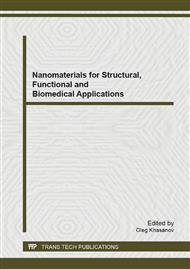[1]
А.М. Aronov, V.F. Pichugin, E.V. Eshenko, М.А. Ryabzeva, R.А. Surmenev, S.I. Tverdokhlebov, E.V. Shesterikov, Thin calcium phosphate coatings obtained by RF magnetron sputtering, and the prospects for their application in medical technology, Med. Tech. 3 (2008).
DOI: 10.1007/s10527-008-9029-9
Google Scholar
[2]
А.М. Aronov, V.F. Pichugin, S.I. Tverdokhlebov, Methodological foundations of medical devices designing and manufacturing, Wind, Tomsk (2007).
Google Scholar
[3]
S.I. Tverdokhlebov, E.N. Bolbasov, E.V. Shesterikov, A.I. Malchikhina, V.A. Novikov, Y.G. Anissimov, Research of the surface properties of the thermoplastic copolymer of Vinilidene Fluoride and Tetrafluoroethylene modified with radio-frequency magnetron sputtering for medical application, Appl. Sur. Sci. 263 (2012).
DOI: 10.1016/j.apsusc.2012.09.025
Google Scholar
[4]
K. Prabakaran, A. Balamurugan, S. Rajeswari, Development of calcium phosphate based apatite from hen's eggshell, Bull. Mater. Sci. 28 (2005) 115–119.
DOI: 10.1007/bf02704229
Google Scholar
[5]
K. Ozeki, T. Yuhta, H. Aoki, I. Nishimura, Y. Fukui, Cristal chemistry of hydroxyapatite deposited on titanium by sputtering technique, Bio-Med. Mat. Eng. 10 (2000) 221-227.
Google Scholar
[6]
W. Tong, J. Chen, X. Li, J. Feng, Y. Cao, Z. Yang, X. Zhang, Preffered orientation of plasma sprayed hydroxyapatite coatings, J. of Mater. Sci. 31 (1996) 3739–3742.
DOI: 10.1007/bf00352788
Google Scholar
[7]
J. Weng, Q. Liu, J. Wolke, D. Zhang, K. De Groot, The role of amorphous phase in nucleating bone-like apatite on plasma-sprayed hydroxyapatite coatings in simulated body fluid, J. Mater. Sci. Lett. 16 (1997) 335–337.
Google Scholar
[8]
D.R. Cooley, A.F. van Dellen, J.O. Burgess, S. Windeler, The advantages of coated titanium implants prepared by radiofrequency sputtering from hydroxyapatite, J. Prost. Dent. 67 (1992) 93–100.
DOI: 10.1016/0022-3913(92)90057-h
Google Scholar
[9]
J.G.C. Wolke, K. van Dijk, H.G. Schaeken, K. de Groot, J.A. Jansen, Study of the surface characteristics of magnetron-sputter calcium phosphate coatings, J. of Biomed. Mater. Res. 28 (1994) 1477–1484.
DOI: 10.1002/jbm.820281213
Google Scholar
[10]
Y. Yang, K. -H. Kim, J.L. Ong, A review on calcium phosphate coatings produced using a sputtering process-an alternative to plasma spraying, Biomat. 26 (2005) 327–337.
DOI: 10.1016/j.biomaterials.2004.02.029
Google Scholar
[11]
K. van Dijk, H.G. Schaeken, J.G.C. Wolke, J.A. Jansen, Influence of annealing temperature on RF magnetron sputtered calcium phosphate coatings, Biomater. 17 (1996) 405–410.
DOI: 10.1016/0142-9612(96)89656-6
Google Scholar
[12]
M. Yoshinari, Т. Hayakawa, J.G.C. Wolke, K. Nemoto, J.A. Jansen, Influence of rapid heating with infrared radiation on RF magnetron-sputtered calcium phosphate coatings, J. of biomed. Mater. Res. 37 (1997) 60–67.
DOI: 10.1002/(sici)1097-4636(199710)37:1<60::aid-jbm8>3.0.co;2-h
Google Scholar
[13]
V.М. Sidorenko, The mechanism of the electromagnetic fields effects on living organisms, Biophys. 46 (2001) 500–504.
Google Scholar
[14]
A.S. Smirnov, Influence of titanium intraosseous implants surface characteristics on bone formation (literature review), New in dentistry, 8 (2000) 25–29.
Google Scholar
[15]
V.А. Solovev, B.N. Davidov, А.B. Suleymanov, Т.V. Shinkarenko, Bone tissue morphological analysis after application of biocomposite materials in the new periosteoplastic method, Inst. of Dent. 1 (2002) 43–46.
Google Scholar
[16]
Т. Albrektsson, C. Johansson, Osteoinduction, osteoconduction and osseointegration, Eur. Spine J. 10 (2001) 96–101.
Google Scholar
[17]
X.X. Wang, X. Wang, Z.L. Li, Effects of mandibular distraction osteogenesis on the inferior alveolar nerve: an experimental study in monkeys, Plast. Reconstr. Surg. 109 (2002) 2373–2383.
DOI: 10.1097/00006534-200206000-00032
Google Scholar
[18]
J. Ferrier, S.M. Ross, J. Kanehisa, J.E. Aubin, Osteoclasts and osteoblasts migrate in opposite directions in response to a constant electrical field, J. Cell. Physiol. 3 (1986) 283–288.
DOI: 10.1002/jcp.1041290303
Google Scholar
[19]
V.A. Klimenov, S.I. Tverdokhlebov, E.N. Bolbasov, E.V. Shesterikov, V.A. Novikov, T.L. Volokitina, Application of atomic-force microscopy methods for testing the surface parameters of coatings of medical implants, Rus. J. of Nondestruct. Test. 47 (2011).
DOI: 10.1134/s1061830911110040
Google Scholar


